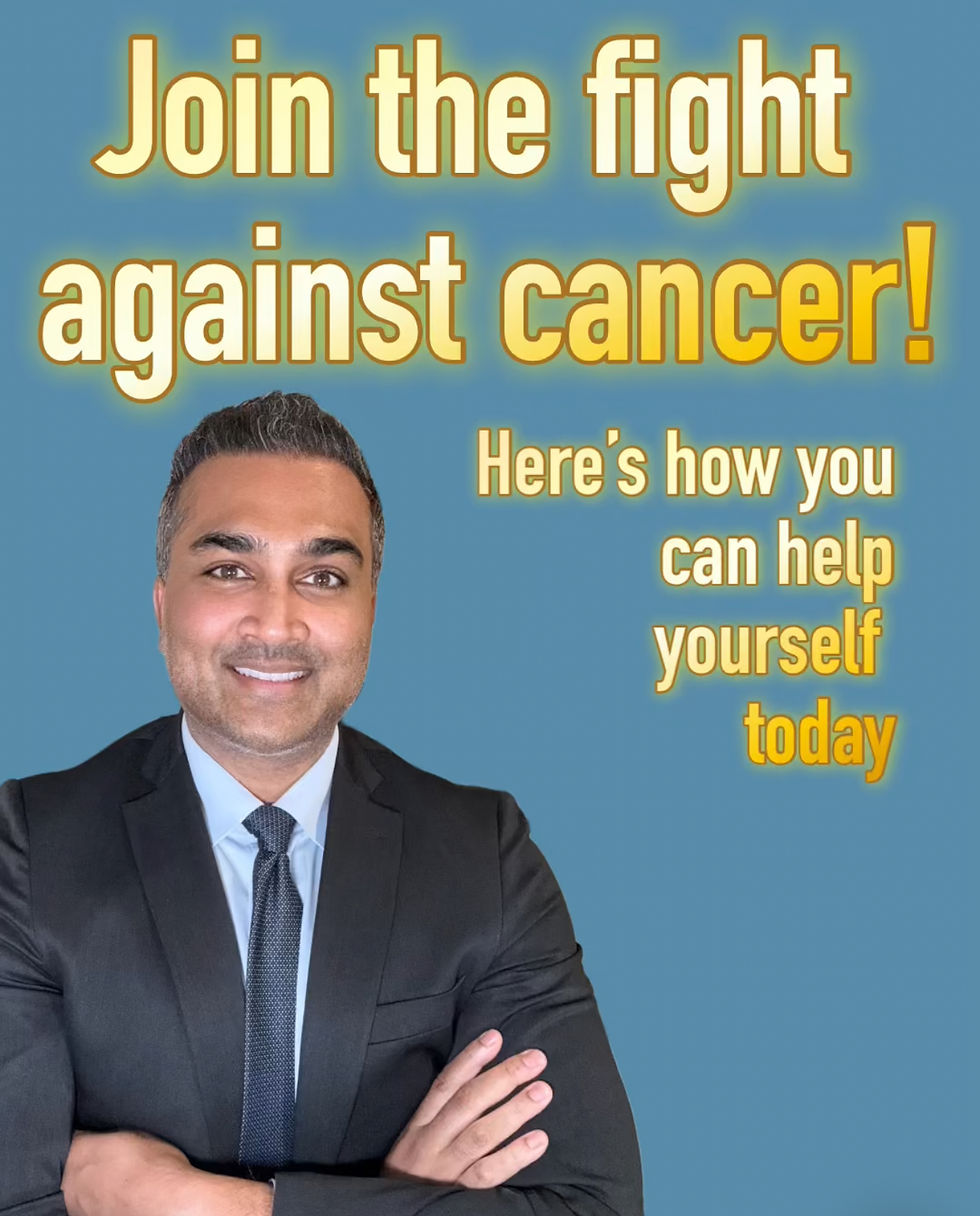Join The Fight Against Cancer - Here's How You Can Help Yourself Today
- Dr. Hansra

- Aug 1
- 8 min read

Cancer is one of the leading causes of death worldwide, but many types of cancer are preventable. Lifestyle factors have been linked to a variety of malignancies, including those common across the globe, such as lung, colorectal, prostate, and breast cancer (Bray et al., 2018) (Romaguera D et al., 2012) Did you know that tobacco use, excess weight, poor diet, and physical inactivity have been implicated in the majority of cancer deaths in the United States and worldwide (Vander Hoorn et al., 2005) By taking charge of your health and making informed lifestyle choices, you can significantly reduce your risk of developing cancer. In this blog post, we will explore key evidence-based recommendations to help you protect yourself and enhance your well-being.
Avoid Tobacco

Avoiding tobacco is one of the most effective ways to prevent cancer. Tobacco contains numerous harmful chemicals that are known to cause several cancers, including lung cancer, head and neck cancers, esophagus cancer, pancreas cancer, liver cancer, stomach cancer, cervix cancer, colon cancer, bladder cancer, kidney cancer, and certain leukemias (Brownson et al., 1993) (Sasco et al., 2004). If you currently smoke, consider utilizing resources such as quit lines, support groups, and nicotine replacement therapies to help you quit.
Creating a smoke-free environment is equally important. Research shows that exposure to secondhand smoke significantly increases the risk of lung cancer in non-smokers (Kim et al., 2015). By avoiding tobacco and protecting others from secondhand smoke, you contribute to healthier living for yourself and those around you.
Be Physically Active

Regular physical activity is essential for a healthy lifestyle and can reduce risk of many cancers including colon, breast, bladder, uterus, esophagus, kidney and stomach cancers (Inoue et al., 2008) (Wolin et al., 2009) (Antonelli et al., 2009) (Patel et al., 2005) (Patel et al., 2019). The American Cancer Society recommends at least 150 minutes of moderate-intensity exercise or 75 minutes of vigorous-intensity activity each week. This includes activities like brisk walking, swimming, or cycling.
Even small changes can make a difference. For instance, taking the stairs instead of the elevator or walking during lunch breaks can help you incorporate more movement into your day.
Maintain a Healthy Weight

Maintaining a healthy weight is crucial for cancer prevention. Being overweight increases, the risk of at least 13 types of cancers including breast, colorectal, and endometrial cancers (Lauby-Secretan et al., 2016). To achieve and maintain a healthy weight, aim to combine a nutritious diet with regular exercise.
To gain insights into your habits, consider tracking your food intake and physical activity using apps or journals. Research indicates that weight loss can significantly lower your risk of developing cancer (Luo et al., 2019) (Shi et al., 2024).
Eat a Nutritious Diet

Your diet plays a key role in your health. A diet rich in fruits, vegetables, and whole grains can reduce cancer risk (Rock et alk., 2020). Aim for at least five servings of fruits and vegetables daily to benefit from the vitamins and antioxidants they provide.
Examples include incorporating leafy greens like spinach, berries, and legumes into your meals. Studies show that a diet high in fiber can lower the risk of several cancers including esophageal, gastric, colon, rectal, colorectal adenoma, breast, endometrial, ovarian, renal cell, prostate, and pancreatic cancers (Hu et al., 2023). Additionally, limit your intake of saturated fats, trans fats, red meat, and processed meats to support overall health.
Limit Alcohol Consumption

While some studies suggest that moderate alcohol consumption may have heart benefits, excess drinking can increase cancer risk (Jun et al., 2023). The more alcohol you consume, the greater your likelihood of developing cancers such as breast cancer, pancreas cancer, prostate cancer, liver cancer, and stomach cancer (Jun et al., 2023).
If you choose to drink, do so responsibly and in moderation. Experts recommend limiting alcohol to one drink per day for women and two drinks per day for men. Studies show that reducing alcohol intake can lead to a significant decrease in the risk of cancer deaths (Esser et al., 2023).
Protect Against Sexually Transmitted Infections (STIs)

Certain STIs, particularly human papillomavirus (HPV), are linked to various cancers, including cervical cancer, anus cancer, head and neck cancers (Alhamlan et al., 2021). Protect yourself by practicing safe sex, such as using condoms, to prevent STIs.
Consider getting vaccinated against HPV, which has been shown to reduce the risk of cervical cancer by nearly 70% (Massad et al., 2009). The vaccine is recommended for preteens and young adults to help safeguard your health and reduce cancer risk.
HIV can increase risk of cervical cancer and non-Hodgkin lymphoma and other cancers (Chen et al., 2015). Also, Hepatitis B virus and hepatitis C virus are associated with liver cancer (Schiefelbein et al., 2012). Keep yourself safe by using condoms and limiting the number of sexual partners and reduce your risk of sexually transmitted diseases and subsequent cancer risk. Also, regular screening for sexually transmitted infections, particularly HPV and HIV, can help identify infections early and allow for timely intervention to prevent cancer development.
Guard Against Sun Exposure

Protecting yourself from harmful UV rays is essential to lower the risk of skin cancer, including melanoma and non-melanoma skin cancer (Sender et al., 2020). Use sunscreen with at least SPF 30, wear protective clothing, and seek shade during peak sunlight hours.
Avoiding tanning beds is crucial as well; studies indicate that using tanning beds before age 30 increases the risk of melanoma by 75% (IARC 2007). Taking these steps can significantly enhance your skin health and lower your chances of developing skin cancer.
Get Regular Cancer Screenings

Regular cancer screenings are vital for early detection, which improves treatment outcomes. Depending on your age, gender, and risk factors, discuss with your healthcare provider to schedule screenings for breast, cervical, colorectal, and lung cancer.
For example, mammograms can detect breast cancer months and years before a lump can be felt. Staying proactive about your health and getting regular screenings can save lives.
Take Charge of Your Health

Preventing cancer requires a comprehensive approach. By following the outlined recommendations such as avoiding tobacco, staying active, maintaining a healthy weight, and eating a nutritious diet, you can lower your cancer risk.
Begin by making small changes that lead to a ripple effect in your lifestyle. Encourage friends and family to join you on this journey to better health. Together, we can create a community focused on cancer prevention and overall well-being.
Now is the time to take control of your health. These simple steps can lead to a healthier life and make a substantial difference in the fight against cancer.
References:
Alhamlan FS, Alfageeh MB, Al Mushait MA, Al-Badawi IA, Al-Ahdal MN. Human Papillomavirus-Associated Cancers. Adv Exp Med Biol. 2021;1313:1-14.
Antonelli JA, Jones LW, Bañez LL, Thomas JA, Anderson K, Taylor LA, Gerber L, Anderson T, Hoyo C, Grant D, Freedland SJ. Exercise and prostate cancer risk in a cohort of veterans undergoing prostate needle biopsy. J Urol. 2009;182(5):2226.
Bray F, Ferlay J, Soerjomataram I, Siegel RL, Torre LA, Jemal A. Global cancer statistics 2018: GLOBOCAN estimates of incidence and mortality worldwide for 36 cancers in 185 countries. CA Cancer J Clin. 2018;68(6):394. Epub 2018 Sep 12.
Brownson RC, Novotny TE, Perry MC. Cigarette smoking and adult leukemia. A meta-analysis. Arch Intern Med. 1993;153(4):469.
Chen CH, Chung CY, Wang LH, Lin C, Lin HL, Lin HC. Risk of cancer among HIV-infected patients from a population-based nested case-control study: implications for cancer prevention. BMC Cancer. 2015 Mar 16;15:133.
Esser MB, Sherk A, Liu Y, Henley SJ, Naimi TS. Reducing Alcohol Use to Prevent Cancer Deaths: Estimated Effects Among U.S. Adults. Am J Prev Med. 2024 Apr;66(4):725-729.Hu J, Wang J, Li Y, Xue K, Kan J. Use of Dietary Fibers in Reducing the Risk of Several Cancer Types: An Umbrella Review. Nutrients. 2023 May 30;15(11):2545.
Inoue M, Yamamoto S, Kurahashi N, Iwasaki M, Sasazuki S, Tsugane S; Japan Public Health Center-based Prospective Study Group. Daily total physical activity level and total cancer risk in men and women: results from a large-scale population-based cohort study in Japan. Am J Epidemiol. 2008 Aug 15;168(4):391-403.International Agency for Research on Cancer Working Group on artificial ultraviolet (UV) light and skin cancer. The association of use of sunbeds with cutaneous malignant melanoma and other skin cancers: A systematic review. Int J Cancer. 2007;120(5):1116.
Jun S, Park H, Kim UJ, Choi EJ, Lee HA, Park B, Lee SY, Jee SH, Park H. Cancer risk based on alcohol consumption levels: a comprehensive systematic review and meta-analysis. Epidemiol Health. 2023;45:e2023092.
Kim CH, Lee YC, Hung RJ, McNallan SR, Cote ML, Lim WY, Chang SC, Kim JH, Ugolini D, Chen Y, Liloglou T, Andrew AS, Onega T, Duell EJ, Field JK, Lazarus P, Le Marchand L, Neri M, Vineis P, Kiyohara C, Hong YC, Morgenstern H, Matsuo K, Tajima K, Christiani DC, McLaughlin JR, Bencko V, Holcatova I, Boffetta P, Brennan P, Fabianova E, Foretova L, Janout V, Lissowska J, Mates D, Rudnai P, Szeszenia-Dabrowska N, Mukeria A, Zaridze D, Seow A, Schwartz AG, Yang P, Zhang ZF. Exposure to secondhand tobacco smoke and lung cancer by histological type: a pooled analysis of the International Lung Cancer Consortium (ILCCO). Int J Cancer. 2014 Oct 15;135(8):1918-30.
Lauby-Secretan B, Scoccianti C, Loomis D, Grosse Y, Bianchini F, Straif K, International Agency for Research on Cancer Handbook Working Group. Body Fatness and Cancer--Viewpoint of the IARC Working Group. N Engl J Med. 2016;375(8):794.
Luo J, Hendryx M, Manson JE, Figueiredo JC, LeBlanc ES, Barrington W, Rohan TE, Howard BV, Reding K, Ho GY, Garcia DO, Chlebowski RT. Intentional Weight Loss and Obesity-Related Cancer Risk. JNCI Cancer Spectr. 2019 Aug 9;3(4).
Massad LS, Einstein M, Myers E, Wheeler CM, Wentzensen N, Solomon D. The impact of human papillomavirus vaccination on cervical cancer prevention efforts. Gynecol Oncol. 2009 Aug;114(2):360-4.
Patel AV, Friedenreich CM, Moore SC, Hayes SC, Silver JK, Campbell KL, Winters-Stone K, Gerber LH, George SM, Fulton JE, Denlinger C, Morris GS, Hue T, Schmitz KH, Matthews CE. American College of Sports Medicine Roundtable Report on Physical Activity, Sedentary Behavior, and Cancer Prevention and Control. Med Sci Sports Exerc. 2019;51(11):2391.
Patel AV, Rodriguez C, Jacobs EJ, Solomon L, Thun MJ, Calle EE. Recreational physical activity and risk of prostate cancer in a large cohort of U.S. men.
Cancer Epidemiol Biomarkers Prev. 2005;14(1):275.
Rock CL, Thomson C, Gansler T, Gapstur SM, McCullough ML, Patel AV, Andrews KS, Bandera EV, Spees CK, Robien K, Hartman S, Sullivan K, Grant BL, Hamilton KK, Kushi LH, Caan BJ, Kibbe D, Black JD, Wiedt TL, McMahon C, Sloan K, Doyle C. American Cancer Society guideline for diet and physical activity for cancer prevention.
CA Cancer J Clin. 2020;70(4):245. Epub 2020 Jun 9.
Romaguera D et al., Is concordance with World Cancer Research Fund/American Institute for Cancer Research guidelines for cancer prevention related to subsequent risk of cancer? Results from the EPIC study. Am J Clin Nutr. 2012 Jul;96(1):150-63. Epub 2012 May 16.
Sasco AJ, Secretan MB, Straif K. Tobacco smoking and cancer: a brief review of recent epidemiological evidence. Lung Cancer. 2004;45 Suppl 2:S3.
Schiefelbein E, Zekri AR, Newton DW, Soliman GA, Banerjee M, Hung ChW, Seifeldin IA, Lo AC, Soliman AS. Hepatitis C virus and other risk factors in hepatocellular carcinoma. Acta Virol. 2012;56(3):235-40.
Sander M, Sander M, Burbidge T, Beecker J. The efficacy and safety of sunscreen use for the prevention of skin cancer. CMAJ. 2020 Dec 14;192(50).
Shi X, Deng G, Wen H, Lin A, Wang H, Zhu L, Mou W, Liu Z, Li X, Zhang J, Cheng Q, Luo P. Role of body mass index and weight change in the risk of cancer: A systematic review and meta-analysis of 66 cohort studies. J Glob Health. 2024 Mar 29;14:04067.
Wolin KY, Yan Y, Colditz GA, Lee IM. Physical activity and colon cancer prevention: a meta-analysis. Br J Cancer. 2009;100(4):611. Epub 2009 Feb 10.







Comments